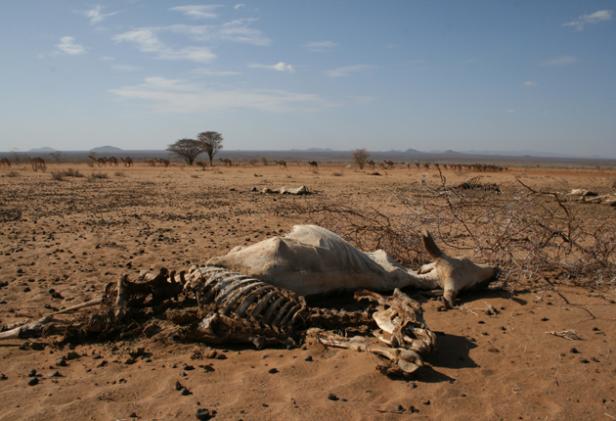Rotting carcasses testify to the scale of the disaster looming in East Africa.

No rainfall for three years has left the Kenyan landscape strewn with animal carcasses
On the plains of Marsabit the heat is so intense the bush seems to shiver. The leafless scrub, bleached white by the sun, looks like a forest of fake Christmas trees. Carcasses of cattle and camels are strewn about the burnt red dirt in every direction. Siridwa Baseli walks out of the haze along a path of the dead and dying. He passes a skeletal cow that has given up and collapsed under a thorn tree. A nomad from the Rendille people, he is driving his herd in search of water.
He marks time in seasons but knows that it has not rained for three years: “Since it is not raining there is no pasture,” he says. Only 40 of his herd of sheep and goats that once numbered 200 have survived. Those that remain are dying at a rate of 10 every day.
Already a herder before Kenya’s independence he has never seen a drought like this.
“If I was young I would go to look for cash work. I am old. I may just die with my animals.”
Across East Africa an extraordinary drought is drying up rivers, and grasslands, scorching crops and threatening millions of people with starvation. In Kenya, the biggest and most robust economy in the region, the rivers that feed its great game reserves have run dry and since the country relies on hydropower, electricity is now rationed in the cities.
And yet, it is in the semi-desert on the southern fringe of the Sahel zone where the most dramatic changes are being felt. Droughts are nothing new here and the nomadic way of life where herders follow patchy rains across the seasons developed centuries ago as a response to precarious natural resources. The herds of cattle, sheep, goats and camels – which are venerated by the nomads – were built up in the good years to pad the margins of life when the rains failed. But this way of life is being overwhelmed, even the camels are dying of thirst.
Read moreThe great drought in East Africa; No rainfall for three years
